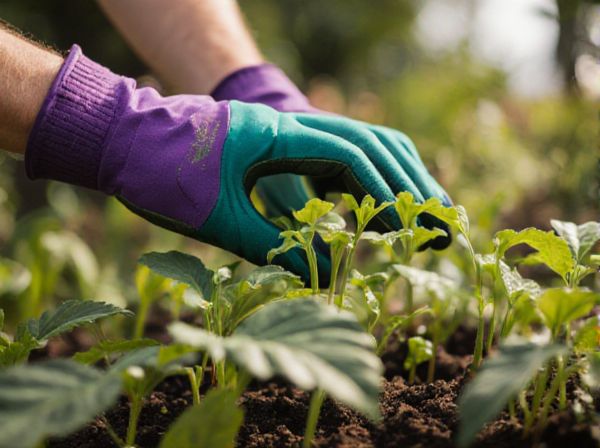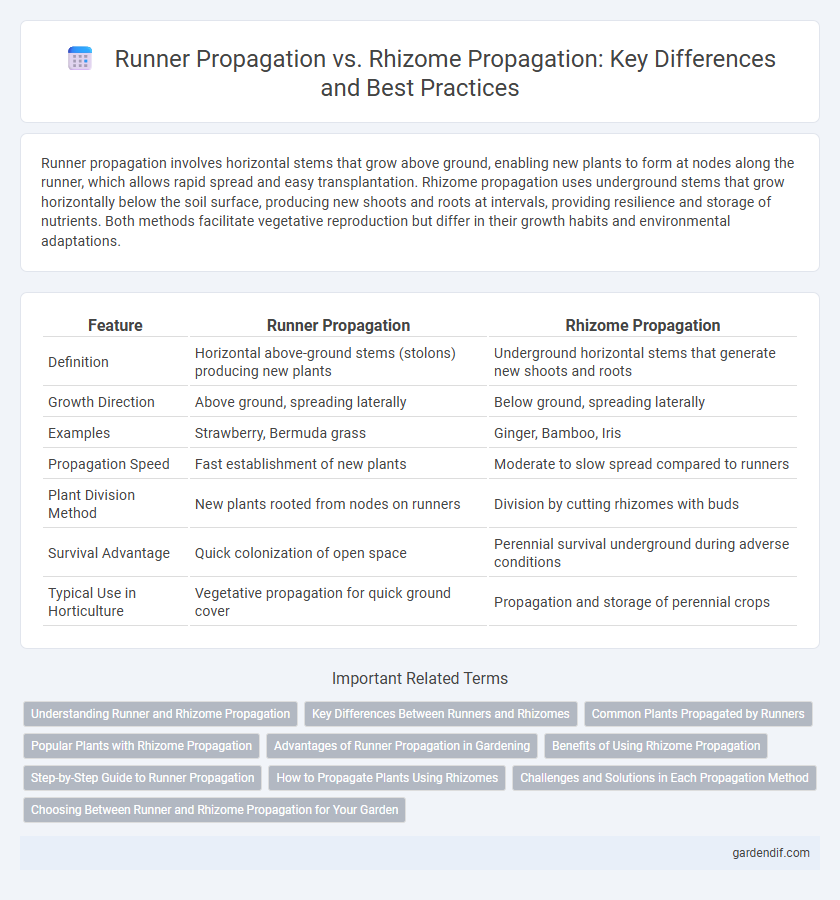
Runner propagation vs rhizome propagation Illustration
Runner propagation involves horizontal stems that grow above ground, enabling new plants to form at nodes along the runner, which allows rapid spread and easy transplantation. Rhizome propagation uses underground stems that grow horizontally below the soil surface, producing new shoots and roots at intervals, providing resilience and storage of nutrients. Both methods facilitate vegetative reproduction but differ in their growth habits and environmental adaptations.
Table of Comparison
| Feature | Runner Propagation | Rhizome Propagation |
|---|---|---|
| Definition | Horizontal above-ground stems (stolons) producing new plants | Underground horizontal stems that generate new shoots and roots |
| Growth Direction | Above ground, spreading laterally | Below ground, spreading laterally |
| Examples | Strawberry, Bermuda grass | Ginger, Bamboo, Iris |
| Propagation Speed | Fast establishment of new plants | Moderate to slow spread compared to runners |
| Plant Division Method | New plants rooted from nodes on runners | Division by cutting rhizomes with buds |
| Survival Advantage | Quick colonization of open space | Perennial survival underground during adverse conditions |
| Typical Use in Horticulture | Vegetative propagation for quick ground cover | Propagation and storage of perennial crops |
Understanding Runner and Rhizome Propagation
Runner propagation involves horizontal stems called stolons that grow above ground, producing new plants at nodes, common in strawberries and spider plants. Rhizome propagation occurs through underground stems that spread laterally, generating new shoots and roots, as seen in ginger and irises. Understanding the difference between runners and rhizomes is crucial for effective plant cultivation and management of spreading habits.
Key Differences Between Runners and Rhizomes
Runners are above-ground horizontal stems that produce new plants at nodes, enabling rapid surface spread ideal for strawberries, while rhizomes are underground stems that grow horizontally beneath the soil, facilitating perennials like ginger to expand and store nutrients. Runners typically generate daughter plants at intervals without forming a dense network, contrasting with rhizomes that form thick, interconnected systems promoting resilience and resource sharing. The key distinction lies in their growth location and method of propagation, where runners favor surface colonization and rhizomes enable subterranean expansion and storage.
Common Plants Propagated by Runners
Common plants propagated by runners include strawberries, spider plants (Chlorophytum comosum), and Bermuda grass (Cynodon dactylon). Runners, also known as stolons, produce new plants by extending horizontal stems that root at nodes, enabling rapid ground coverage and vegetative reproduction. This method contrasts with rhizome propagation, where underground stems allow species like ginger and bamboo to spread below the soil surface.
Popular Plants with Rhizome Propagation
Popular plants with rhizome propagation include ginger, turmeric, and iris, which utilize underground stems to spread and establish new growth. Rhizomes store nutrients, enabling these plants to survive adverse conditions and rapidly colonize an area. This method contrasts with runner propagation, where above-ground horizontal stems produce new plants, commonly seen in strawberries.
Advantages of Runner Propagation in Gardening
Runner propagation accelerates plant spread by producing genetically identical offspring swiftly, enabling gardeners to establish dense ground cover efficiently. This method requires minimal space and resources compared to rhizome propagation, reducing the risk of soil-borne diseases. Healthy strawberry plants and spider plants often benefit from runner propagation due to its ease and high success rate.
Benefits of Using Rhizome Propagation
Rhizome propagation offers increased plant stability and enhanced nutrient storage compared to runner propagation. Plants grown from rhizomes exhibit greater resilience to environmental stress and improved long-term growth potential. This method ensures uniformity and robustness in perennial crops like ginger and bamboo.
Step-by-Step Guide to Runner Propagation
Runner propagation involves the natural formation of horizontal stems called stolons that produce new plantlets at nodes, making it an efficient method for plants like strawberries and spider plants. To propagate runners, identify healthy runners with developed plantlets, gently place these plantlets on moist soil while still attached to the parent plant, and secure them with pins or small weights to encourage root formation. After roots establish, typically within two to three weeks, sever the runner connection to allow the new plantlets to grow independently.
How to Propagate Plants Using Rhizomes
To propagate plants using rhizomes, carefully dig up the parent plant to expose the horizontal underground stems. Cut the rhizome into sections, ensuring each piece has at least one healthy bud or growth node for successful rooting. Plant the rhizome segments in well-draining soil, keeping them moist and shaded until new shoots emerge.
Challenges and Solutions in Each Propagation Method
Runner propagation faces challenges such as vulnerability to environmental stress and limited genetic diversity, which can reduce plant resilience. Solutions include selecting hardy runner varieties and optimizing soil moisture to enhance root establishment. Rhizome propagation confronts issues like disease transmission and slower propagation rates; implementing disease-resistant cultivars and using tissue culture techniques can improve rhizome health and multiplication efficiency.
Choosing Between Runner and Rhizome Propagation for Your Garden
Runner propagation produces new plants from above-ground horizontal stems, making it ideal for rapid spreading in garden beds with ample space. Rhizome propagation involves underground stems that allow plants to establish dense, resilient root systems suitable for controlling erosion and stabilizing soil. Selecting between runners and rhizomes depends on your garden layout, desired plant density, and maintenance preferences.
Runner propagation vs rhizome propagation Infographic

 gardendif.com
gardendif.com